A practical guide showing how a $50k salary can afford a $250k home, covering deposit, mortgage math, extra costs, and tips for first‑time buyers in Auckland.
House Affordability
When talking about House Affordability, the ability to purchase or rent a home without stretching finances beyond sustainable limits. Also known as home affordability, it depends on income, debt, savings and local market prices.
One of the first hurdles is the down payment, the upfront cash a buyer must provide to secure a mortgage. A larger down payment lowers monthly payments and improves loan terms, but many buyers struggle to gather enough cash. That’s where shared ownership, a scheme that lets you buy a percentage of a property and pay rent on the remaining share enters the picture. Shared ownership can shrink the cash you need today while still giving you a foot in the property ladder.
For a first‑time homebuyer, someone purchasing their first residence, often with limited equity and a tighter budget, affordability blends the down payment challenge with the available assistance programs. Government grants, low‑interest loans, and mortgage credit certificates can all tip the scales. When these tools line up, the overall cost of homeownership falls into a manageable range, making the dream of owning a house feel realistic rather than out of reach.
What Shapes Your Ability to Afford a Home?
House affordability isn't just about price tags; it’s a web of factors that interact daily. Your gross income sets the ceiling, but lenders also look at debt‑to‑income ratios, credit scores, and future earning potential. The local market influences what you can get for your money – some regions need a hefty deposit, while others offer affordable starter homes. On top of that, ongoing costs like council tax, insurance, and maintenance eat into your budget.
Affordability requires a clear picture of these pieces. Start by calculating the maximum monthly housing cost you can sustain—most experts suggest keeping it under 30% of net income. Then, estimate the total cash you’ll need up front: down payment, legal fees, stamp duty, and moving expenses. If the sum feels too high, explore shared ownership or look for first‑time buyer schemes that can cover part of the gap.
Understanding how each element fits together helps you avoid surprises down the line. A realistic affordability assessment lets you choose a property that matches your financial comfort zone, reduces stress, and increases the odds of a successful purchase or rental.
Below you’ll find a curated set of articles that break down each of these topics in detail. From calculating the 50% rule for rental investors to decoding Virginia’s credit‑score requirements, the collection gives you practical steps, real‑world examples, and the latest program updates to help you master house affordability today.
